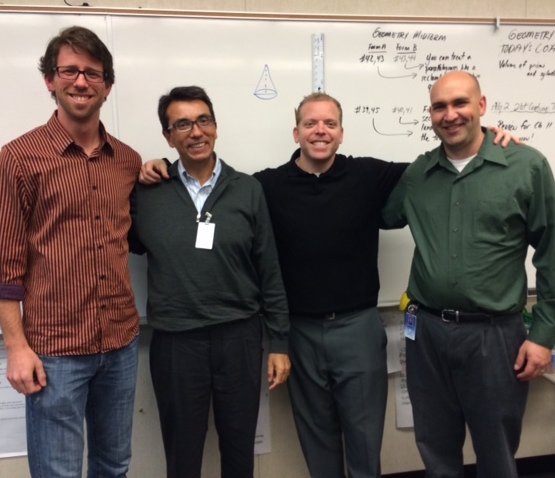
Gregory Duran and Colleagues
May 1, 2014
On this date we featured Gregory Duran, a teacher on special assignment (TOSA), and his colleagues, math teachers Matt Cooley, Kenon Willis, David Andzejewski and Colin O'Haire in the San Ramon Valley Unified School District.
In his special assignment, Gregory is responsible for helping other math teachers implement curriculum, and this group is committed to engaging students with courses that integrate computer programming and mathematics. (Pictured in photo, from left to right: Matt Cooley, Gregory Duran, Kenon Willis and David Andzejewski).
One of those courses is UCCI's Algebra 2 for the 21st Century, developed at the Summer 2012 Institutes. It integrates Algebra 2 content with game, simulation, and software development concepts and is designed as part of the Software and Systems Development CTE Pathway of the Information and Communication Technologies CTE Industry Sector. Gregory was a participant at the Summer 2012 UCCI Institutes, and when he learned of this course, he realized that it would be a great fit for his district's schools.
Algebra 2 for the 21st Century wasn't the first UC-approved, integrated math-computer course in the SRVUSD, however. Gregory had already collaborated with Pleasanton computer scientist Pierre Bierre to develop Algorithmic Geometry, in which students use Java algorithms to solve a variety of geometry problems. The district was able to implement Algorithmic Geometry with an educational grant from the Lawrence Livermore National Laboratory (LLNL). Gregory credits Stan Hitomi, a principal in the district, with helping make the LLNL connection that ultimately led to this course offering.
Having had experience with their own integrated course, Gregory's colleagues were enthusiastic about securing district and school board approval for the UCCI course. Like all UCCI course offerings, Algebra 2 for the 21st Century is UC-approved and that, Gregory says, “was huge.” Gaining local approval is much easier, he says, “if UC says, 'We already endorsed this.'”
“What I like about our school district,” Gregory says, “is that the administration team has a view on life of 'Yes, and —'. You know, once you say 'No,' it kills everything. But with 'Yes, and—' you can go on to find a better way to move things forward.”
Dougherty Valley, San Ramon Valley and Monte Vista high schools began teaching Algebra 2 for the 21st Century in fall 2013.
Math teacher David Andzejewski shared, “Some kids got hooked on the need for the program to work, resulting in many hours spent outside of class working on their programs.”
Kenon Willis says he knew the course would “give students the opportunity to practice the logic of computer programming. I expected the students to be able to take a bigger project, break it down into its smaller parts, then construct each part to make the whole project work.”
On the whole, that is how the course has worked, although Kenon notes that the biggest challenge is getting through all the math curriculum and the programming curriculum in the instructional time allowed. When he next teaches the course, he says, he has plans to start each lab day with a mini-lesson introducing students to the next feature of Scratch they'll be using.
“I structured it this year,” Kenon says, “where it was an exploration learning process, without much instruction in the lab. It worked, but a lot of questions could be eliminated with a short lesson beforehand.”
One thing students quickly discovered is that Algebra 2 for the 21st Century is not an easier version of a traditional Algebra 2 course. Some students who signed up for it dropped the course after the first three weeks, and the teachers believe it was because they'd thought it would be easy.
The students who stuck with it, however, learned to create and implement math algorithms, which led them to a fun payoff: They could create their own games.
It's not surprising, then, that student engagement in the course is high, especially when they are working on programming with Scratch. They also learned to use programs like Desmos and Geogebra to analyze graphs, teacher Matt Cooley says. “Students look forward to days when they are on the computer.”
“The students are certainly engaged when they are working on their Scratch projects,” says Colin O'Haire. “They enjoy the challenge of the math-based projects, and they are adept at taking what they have already learned and applying it to reach their goals.”
David Andzejewski found that his students like the instant feedback they get from a computer program. “It either works or it does not work,” he says. “Moreover, some kids got hooked on the need for the program to work, resulting in many hours spent outside of class working on their programs.”
Programming and math concepts are a natural subject pairing for integration, Gregory Duran says, especially when it comes to the eight math practices that are part of the Common Core State Standards for math.
“Programming is a fantastic way to teach kids the eight math practices all in one shot.” he says. “They have to do all of the math practices in the development of the algorithms, and then program the algorithms to make (games and simulations) work.”
As much as teachers learn about course-development at the UCCI Institutes, they learn even more by bringing the completed course to the classroom.
“Not until we get the curriculum in front of the kids do we get a feeling of how this course is going to emerge. One of the things we learned in front of kids is that the creation of algorithms is much more rich mathematically than the creation of games,” Gregory says. “The programming really has to be around the mathematical algorithm development and then putting the game as a shell around that.”
